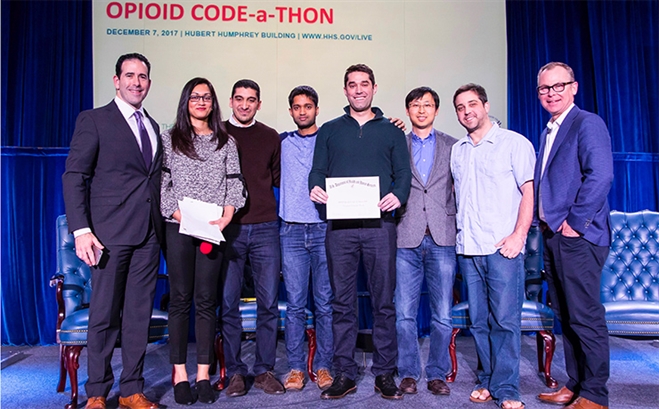Connecticut Data Sparks Winning App for Opioid Crisis
January 05, 2018 by Melissa Crowe

When a Yale University medical student, a Google software engineer, a machine learning engineer from Palantir, a Johns Hopkins pain management physician, and a Stanford pain researcher spent two hours scouring the internet for data that could inform their research, they stopped their search at Connecticut's open data portal.
"We came across this Connecticut dataset in Socrata. We noticed Connecticut puts a lot of this stuff online and makes a lot of their data open, as well," says Matthew Erlendson, a Yale medical student and founder of innovation lab Origami Innovations. "What was great about that dataset is that we had what we needed. This one had the location of overdose, location of death, type of drug, the date, and the times."
This team of super minds had gathered at the recent U.S. Department of Health and Human Service's (HHS) National Opioid Symposium and Code-a-Thon in Washington, DC in early December 2017, representing Origami Innovations. Erlendson says, "Our idea was, 'What does the model city look like to deal with the opioid crisis?'"
They focused on and followed a human-centered, patient-centered, design-thinking approach that considered the whole journey in opioid addiction, including how pain medications are prescribed, how excess pills are dropped off, education on using them, and more.
The team also wanted to consider the role of physicians, patients who need opioid medication, public health specialists, first responders, and others in the medical field in their solution, not just focus on those struggling with addiction.
The Power of Data
Erlendson and his teammates came into the event with no specific app in mind. They wanted to create something that could "be implemented the next day." They took to the time to talk with people on site who deal daily with the opioid crisis, including Joe Riffe, an EMT and chronic pain patient who attended the event. Joe shared an anecdote with the team that influenced their idea for an app.
Riffe said that he uses analog data by calling up EMTs in other counties to ask if they've had a spike in overdoses recently. According to Riffe, an increase in opioid overdoses in a nearby county almost always means that a similar rise will happen in his county in the coming two weeks.
The key, Riffe says, is to have enough supplies to handle a spike. First responders need enough drugs like Naloxone, or Narcan, that block the effects of opioids in the body and can prevent death from overdose. Joe recalled a recent situation where he believed more lives could have been saved if his team had had access to adequate Narcan supplies when a spike in overdoses occurred.
Fascinated and inspired by Joe's story, the Origami Innovations team shifted their online search to datasets they could use to create a predictive model around locations of spikes in opioid overdoses and deaths. When the team found the Connecticut dataset they knew it had potential, even though it was small.
"We all started looking around at different datasets and we would think, 'This is great but it doesn't have this or it doesn't connect back to the patient or back to the provider, and so on.' Then the team found the Connecticut dataset. My first reaction was, 'From a machine learning perspective, this is really small.' But then Satcha and Jack said, 'We can actually use a model and make it work,'" says Stanford pain researcher Dara Rouholiman.
Because so much of the opioid crisis is happening in less populated communities, the Origami Innovations team actually considered the model running on small amounts of data a win for everyone.
"Small data is still impactful, especially in smaller cities and counties where access to big data is limited," says Erlendson.
A Winning Idea
When the awards ceremony arrived, the Origami Innovations team won in the Treatment track.
Looking Ahead
Google engineer and recent Yale graduate, Sachith Gullapalli , is enthused about the potential of the app. He says, "What drew me to the project was, I have always believed there is a lot of data out there, especially in governments and healthcare, that is not being fully utilized. If you look at the stuff tech companies are doing today when it comes to optimizing ads. They're using these incredibly robust models. They come up with really good predictions. They take data from all these sources and make fundamentally impressive predictions about what is going to happen next. We don't that level of sophistication in other domains. And, it's something that could be equally useful and have a much larger impact."
The whole team agrees that they want to gather even more data and validate the model they have created. Erlendson is also in communication with leaders at Yale University and the state of Connecticut who are interested in supporting the further development of the app.
During the team's app presentation, Erlendson said, "By predicting the future and working on resource allocation, regardless of size or data collection abilities, we believe this platform can save lives as soon as tomorrow in New Haven and in your community." The team wants to expand the app's use to other states.
As a final message to government organizations across the country, the team hopes more data on opioids is made available soon. "The bottleneck is always data. The model we built during the code-a-thon was the best given the data we had. But, public health departments have way more data that isn't publicly available. The model can only get better with more data. There is a lot of untapped potential," says Gullapalli.